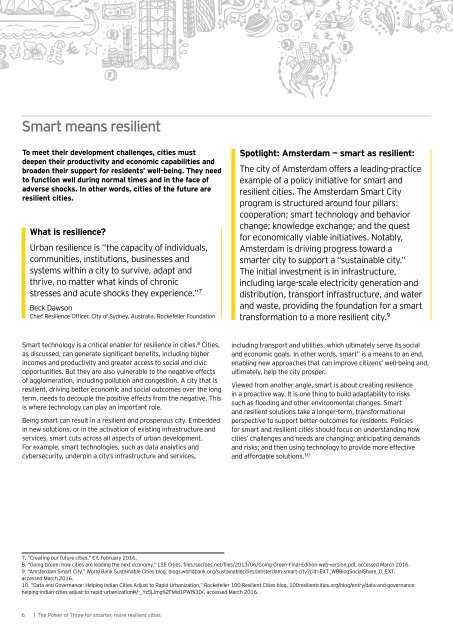The Power of Three for smarter more resilient cities
60198pEJX
60198pEJX
You also want an ePaper? Increase the reach of your titles
YUMPU automatically turns print PDFs into web optimized ePapers that Google loves.
Smart means <strong>resilient</strong><br />
To meet their development challenges, <strong>cities</strong> must<br />
deepen their productivity and economic capabilities and<br />
broaden their support <strong>for</strong> residents’ well-being. <strong>The</strong>y need<br />
to function well during normal times and in the face <strong>of</strong><br />
adverse shocks. In other words, <strong>cities</strong> <strong>of</strong> the future are<br />
<strong>resilient</strong> <strong>cities</strong>.<br />
What is resilience?<br />
Urban resilience is “the capacity <strong>of</strong> individuals,<br />
communities, institutions, businesses and<br />
systems within a city to survive, adapt and<br />
thrive, no matter what kinds <strong>of</strong> chronic<br />
stresses and acute shocks they experience.” 7<br />
Beck Dawson<br />
Chief Resilience Officer, City <strong>of</strong> Sydney, Australia, Rockefeller Foundation<br />
Spotlight: Amsterdam — smart as <strong>resilient</strong>:<br />
<strong>The</strong> city <strong>of</strong> Amsterdam <strong>of</strong>fers a leading-practice<br />
example <strong>of</strong> a policy initiative <strong>for</strong> smart and<br />
<strong>resilient</strong> <strong>cities</strong>. <strong>The</strong> Amsterdam Smart City<br />
program is structured around four pillars:<br />
cooperation; smart technology and behavior<br />
change; knowledge exchange; and the quest<br />
<strong>for</strong> economically viable initiatives. Notably,<br />
Amsterdam is driving progress toward a<br />
<strong>smarter</strong> city to support a “sustainable city.”<br />
<strong>The</strong> initial investment is in infrastructure,<br />
including large-scale electricity generation and<br />
distribution, transport infrastructure, and water<br />
and waste, providing the foundation <strong>for</strong> a smart<br />
trans<strong>for</strong>mation to a <strong>more</strong> <strong>resilient</strong> city. 9<br />
Smart technology is a critical enabler <strong>for</strong> resilience in <strong>cities</strong>. 8 Cities,<br />
as discussed, can generate significant benefits, including higher<br />
incomes and productivity and greater access to social and civic<br />
opportunities. But they are also vulnerable to the negative effects<br />
<strong>of</strong> agglomeration, including pollution and congestion. A city that is<br />
<strong>resilient</strong>, driving better economic and social outcomes over the long<br />
term, needs to decouple the positive effects from the negative. This<br />
is where technology can play an important role.<br />
Being smart can result in a <strong>resilient</strong> and prosperous city. Embedded<br />
in new solutions, or in the activation <strong>of</strong> existing infrastructure and<br />
services, smart cuts across all aspects <strong>of</strong> urban development.<br />
For example, smart technologies, such as data analytics and<br />
cybersecurity, underpin a city’s infrastructure and services,<br />
including transport and utilities, which ultimately serve its social<br />
and economic goals. In other words, smart” is a means to an end,<br />
enabling new approaches that can improve citizens’ well-being and,<br />
ultimately, help the city prosper.<br />
Viewed from another angle, smart is about creating resilience<br />
in a proactive way. It is one thing to build adaptability to risks<br />
such as flooding and other environmental changes. Smart<br />
and <strong>resilient</strong> solutions take a longer-term, trans<strong>for</strong>mational<br />
perspective to support better outcomes <strong>for</strong> residents. Policies<br />
<strong>for</strong> smart and <strong>resilient</strong> <strong>cities</strong> should focus on understanding how<br />
<strong>cities</strong>’ challenges and needs are changing; anticipating demands<br />
and risks; and then using technology to provide <strong>more</strong> effective<br />
and af<strong>for</strong>dable solutions. 10<br />
7. “Creating our future <strong>cities</strong>,” EY, February 2016.<br />
8. “Going Green: how <strong>cities</strong> are leading the next economy,” LSE Cities, files.lse<strong>cities</strong>.net/files/2013/06/Going-Green-Final-Edition-web-version.pdf, accessed March 2016.<br />
9. “Amsterdam Smart City,” World Bank Sustainable Cities blog, blogs.worldbank.org/sustainable<strong>cities</strong>/amsterdam-smart-city?cid=EXT_WBBlogSocialShare_D_EXT,<br />
accessed March 2016.<br />
10. “Data and Governance: Helping Indian Cities Adjust to Rapid Urbanization,” Rockefeller 100 Resilient Cities blog, 100<strong>resilient</strong><strong>cities</strong>.org/blog/entry/data-and-governancehelping-indian-<strong>cities</strong>-adjust-to-rapid-urbanization#/-_Yz5jJmg%2FMid1PWI%3D/,<br />
accessed March 2016.<br />
6 | <strong>The</strong> <strong>Power</strong> <strong>of</strong> <strong>Three</strong> <strong>for</strong> <strong>smarter</strong>, <strong>more</strong> <strong>resilient</strong> <strong>cities</strong>


